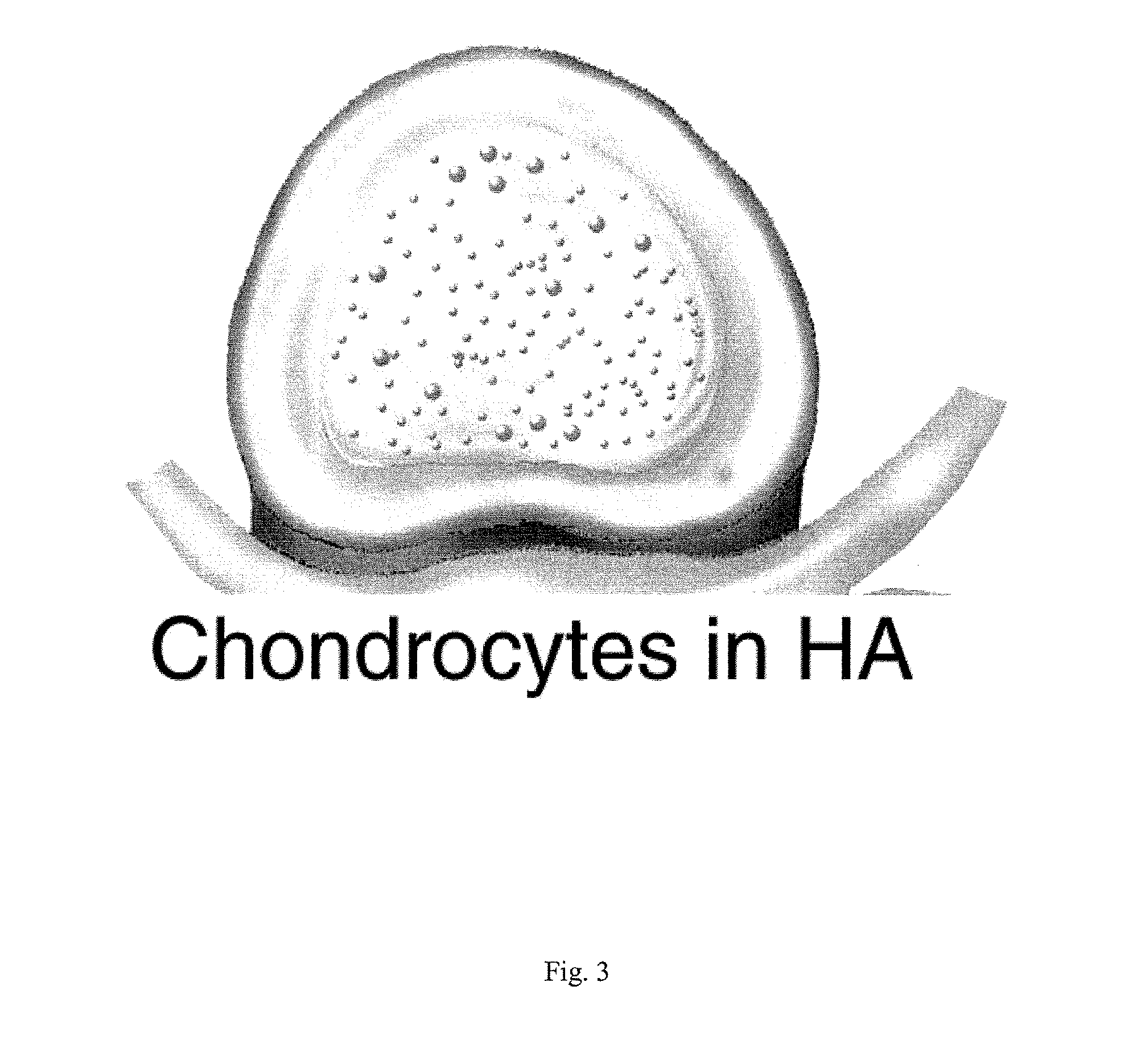Intervertebral disc repair, methods and devices therefor
a technology of intervertebral discs and repair methods, applied in the field of intervertebral discs, can solve the problems of significant health care, economic and social costs, and unfavorable height or posture changes, and achieve the effects of reducing the risk of injury
- Summary
- Abstract
- Description
- Claims
- Application Information
AI Technical Summary
Benefits of technology
Problems solved by technology
Method used
Image
Examples
example 1
[0052]This example illustrates transplantation and survival of human chondrocytes transplanted into canine intervertebral disc tissue.
[0053]In this example, a pilot animal study was conducted to determine whether human articular chondrocytes survive injection to produce cartilaginous matrices in experimental defects created in the intervertebral disk of adult canines. Gross morphologic and histological results obtained from this short-term pilot study (12 weeks) demonstrate that implanted chondrocytes can survive to produce cartilaginous matrices which integrate with surrounding host tissues.
[0054]Surgical Procedure: Prior to induction of anesthesia, six adult female dogs were sedated by the attending veterinarian or the veterinary technician / anesthetist using one of the following combinations: Atropine 0.05 mg / kg IM with or without Acepromizine 0.05-0.2 mg / kg IM. An 18 or 20 gauge 1¼ to 2 inch angio-catheter was placed in the cephalic saphenous or auricular vein for venous access. ...
example 2
[0071]This example illustrates preparation of chondrocytes. In these experiments, the joint capsule and underlying muscle were aseptically removed from a donor cadaver to expose the articular cartilage. Donors were either human (ages between 28 weeks and 3 years) or porcine (5 day old male Sinclair Minipig). The cartilage was manually recovered in small, approximately ˜1 mm thick by ˜2-3 mm rectangular pieces suitable for the digestion / isolation step. The recovered articular cartilage was placed in medium formulation HL-1 (Cambrex Corporation, East Rutherford, N.J.) supplemented with 50 μg / mL Gentamicin, 50 μg / mL L-ascorbic acid and 4 mM L-glutamine. The cells were digested free of the surrounding matrix with a purified collagenase / neutral protease, Liberase Blendzyme 2® (Roche Applied Science) at a concentration of 1.6 WU / mL. The digestion mixture was incubated at 37° C. until the digestion is complete. After digestion, any undigested material was removed by straining through a 70 ...
example 3
[0072]This example illustrates expansion of chondrocytes.
[0073]Chondrocytes digested from the matrix described in Example 2 were seeded at a density of 5×106 cells / T150 flask in 30 mL of expansion medium (HL-1) supplemented with Gentamicin, L-ascorbic acid, L-glutamine, bFGF, TGF-β and 0.1% sodium hyaluronate and cultured in a 5% CO2-37° C.-humidified incubator for 19 days. Every 3-4 days fresh medium was provided to the cells. At the first two feedings, 15 mL of expansion medium was aseptically added to each flask. At subsequent intervals, approximately 50% of the spent medium was replaced. On day 19 of culture, chondrocytes were enzymatically released from the substrate with Liberase Blendzyme 2® (0.4 WU / mL). Digestion of flasks was carried out at 5% CO2-37° C. in a humidified incubator. After a minimum of 4 hours of digestion, the morphology of the cell clusters were observed. Digestion was determined to be complete when clusters of only 3-4 cells were seen in suspension. Once di...
PUM
| Property | Measurement | Unit |
|---|---|---|
| compression force | aaaaa | aaaaa |
| compression force | aaaaa | aaaaa |
| time | aaaaa | aaaaa |
Abstract
Description
Claims
Application Information
 Login to View More
Login to View More - R&D
- Intellectual Property
- Life Sciences
- Materials
- Tech Scout
- Unparalleled Data Quality
- Higher Quality Content
- 60% Fewer Hallucinations
Browse by: Latest US Patents, China's latest patents, Technical Efficacy Thesaurus, Application Domain, Technology Topic, Popular Technical Reports.
© 2025 PatSnap. All rights reserved.Legal|Privacy policy|Modern Slavery Act Transparency Statement|Sitemap|About US| Contact US: help@patsnap.com



